-
Posts
701 -
Joined
-
Last visited
Content Type
Profiles
Forums
Gallery
Events
Posts posted by Mark Pearse
-
-
well done, going well Vaddoc
- Keith Black, mtaylor and cog
-
 3
3
-
-
Hi Vaddoc
You're making good progress, & those runner blocks for the deck are excellent, angled for the lead angle. On the things you're not sure about, hopefully some comments below might help. But they are just my opinions, & it is a model rather than a real boat - don't feel obliged to do the same thing as you'd do on a yacht.
1. On the top of the coaming isn't practical, too many things would get caught around them & also injury risk. My suggestion is the outside of the coaming, but they shouldn't need mounting blocks.
2. I don't think that's ok, it would foul for sure - sheets should lead fully inside the shrouds or fully outside. Outer jibs are always going to be set more loosely than inner ones, & the sheeting line would likely go outside the shrouds.
3. Blocks on the clew of any headsails is a risk on a real yacht - even a 10mm diameter sheet can hurt a lot if the wind is up & the sail is flogging, a block would be dangerous. I think that a 2:1 system that has to tack around the forestay would be trouble in general. But if you still want to proceed (reality with modelling being your own decision of course), you can mount the end wherever you want....what about making the sheet block a becket block & tie it off there?
4. If you prefer not to have winches, then a separate tackle is one easy way to get sufficient sheet tension. I can't speak generally about boats in general, but I have used one system where you have a separate block & tackle somewhere handy & after tacking someone gets it out & puts one end of the tackle on the sail & the other end somewhere close to the cleat & hauls on the tackle. Then removes the slack from the jib sheet & puts the tackle away again. A handy-billy is what we call it. So if you follow this approach the sheet would just be a single line going to the cleat.
Hope it helps, if it's not clear let me know.
-
Bravo Keith, & it's nice to see the model photographed in daylight.
There must be an interesting system for the ventilation, & I would guess that some vents might not ever be rotated forwards - you'd probably always want the heads & bilges to be sucking air out.
- Keith Black, Bedford, KeithAug and 1 other
-
 4
4
-
-
Hi Steven
what is the rope that's like a downhaul - it's going downwards & in your photo is to the left of the mast? Is it to tension downwards against the halyard pulling up?
- EJ_L, mtaylor and Louie da fly
-
 3
3
-
Bravo, that's looking very nice. The sails came up great.
- FriedClams, vaddoc, mtaylor and 1 other
-
 4
4
-
-
-
Hi Keith
That looks fantastic. The illusion of scale is getting better & better.
Looking at the images, it occurred to me that another possibility for the mystery cleats is lashing points for the boom. A simple lashing to the boom stand would suffice in many cases - but in difficult conditions more would be needed to restrain it all as the boat lurched around. Aligning with the helm, lashings would interfere less with the most critical sight lines. Maybe.
- Moab, Keith Black, mtaylor and 2 others
-
 5
5
-
Hi George
Very interesting subject, the rope truss is fantastic & very believable.
On the mystery stone weights, one possible use is to assist the anchor. There's no doubt that a dead weight as an anchor is better than nothing, but a boat would pull slightly up - & with more wind a dead weight would tend to slide along the sea bed. If you use an anchor kellet, the pull on the anchor from the boat is horizontal with little "up" pull, & changes the anchor from being just a dead weight on a rope to the shape of the stone being a purposeful design. If you allow me to speculate: assuming the anchor is carefully lowered from the top rope to sit on the sea bed standing up, you then release that rope & the line to then hold the boat at anchor is now to the lower corner hole, then the pull on the anchor (if you use a kellet) is more horizontal, & the splayed face on the anchor would bite into the sand or mud instead of sliding. My guess is that the "top" rope on the anchor is for lowering & weighing only. I'll find an image online of a kellet & add it below. It's a simple but very effective anchoring tool.
The mystery rocks could easily have had multiple uses, this is just one more possibility.

- paulsutcliffe, tkay11, mtaylor and 5 others
-
 8
8
-
Hi Vaddoc
I don't have a lot of experience with topsails, but I don't think they need much adjustment - they tend to do what the mainsail does. I thought that they don't need much once set up. That's if you want to free up one of the cleats.
On the jibs, are you thinking of putting blocks on the sail clews?
-
On 5/18/2020 at 9:33 AM, Louie da fly said:
Which is why I put the holes at the bottom of the block as part of the tackle, rather than at the top, where they'd each take 1/3 of the total load on the halyard.
The blocks are really ingenious.The other aspect - which was clear from your sketch - is that the three lines will also help stabilise the block & keep it from twisting out of square, sheaves can jamb horribly if that happens.
-
Hi Vaddoc
Good question, & I believe the expert opinion is that in a yacht there's a beam:length ratio that shouldn't be exceeded. However, the conventional wisdom isn't foolproof - our own yacht is 3m beam & 7.3m hull length, so very beamy - as a design almost 90 years old she is comparable sail performance to a modern cruising yacht of the same length, & in lighter winds we can usually convincingly beat comparable modern boats. The Karoo isn't a yacht as such, but I think some things do apply.
A hull's 'righting moment' is key, it balances the wind power. The two simple ways of giving righting moment are ballast & positive buoyancy. Ballast is easy & we all understand that. Positive buoyancy is the resistance of a shape to being pushed into the water - so it "pushes back" when you try to tip the boat. A beamy boat has more than a narrow shape simply because it's wider. So ..... you can then get rid of some ballast & make the boat lighter - less weight, less wetted area etc. It's a balance, there is no one approach that is right or wrong, the best designers can do this remarkable balance...& they can still come up with a great looking boat.
-
She's really coming together. The area of the spreaders has a lot going on & is very neatly done.
- cog, mtaylor and FriedClams
-
 3
3
-
Hi Keith
Very interesting on the wire hardening.
I wonder if the slots are because they use the tubes to double as vents for the black & grey water holding tanks.
- mtaylor, KeithAug, Keith Black and 1 other
-
 4
4
-
4 hours ago, cog said:
Thought I saw it in Open Boat by I.H. Smith but that can't be since those are 18'
Hi Carl
Nice to hear from you. You are widely read on boats if you know this book. I'm guessing you're thinking of the 18 foot skiffs, & there is certainly some influence. The Karoo is like an 18' skiff with more boat & less sail.
The skiffs had larger sail areas & 10 or 12 crew to keep it up & work it all - spinnaker poles had 3, 4 or 5 pieces each around 3.5m long. Their hulls are wider & shallower, but the lines are certainly similar. Cliff Gale did race the 18 foot skiffs, & his thinking in the Karoo design is influenced by them. Karoo would be manageable single-handed if it wasn't very windy, & raced with 3 or 4 crew.
18' skiff Brittania, 1920s - so same period as Karoo
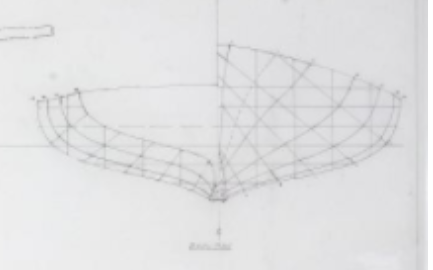
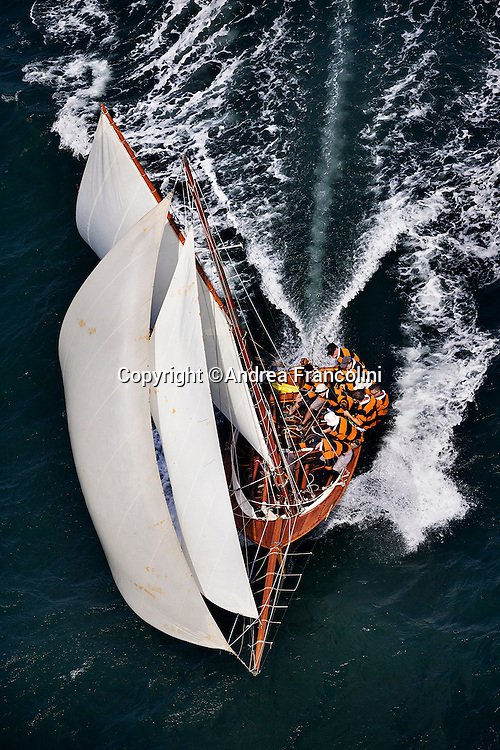
- druxey, Jim Cricket, GrandpaPhil and 2 others
-
 5
5
-
Dick,
A very interesting & enjoyable build to follow, & beautifully displayed in the photo above. Is that a reproduction of Durer on the left?
- cog, Louie da fly and mtaylor
-
 3
3
-
-
-
-
-
Hi everyone
This is my second venture into model boat building. The first model was an unbuilt yacht design by a Sydney amateur yacht designer; this one is a much earlier design by the same man - E.C. "Cliff" Gale. Karoo was a 20' open sailing boat with a bowsprit & gaff sloop rig. Karoo was raced & was also a family boat. Incredibly they (Cliff & Mrs Gale, plus 3 strapping young sons) used to pack her full of gear for holidays & spend a week or two aboard on Pittwater, Broken Bay & the associated waterways Cowan Creek, Coal & Candle Creek etc.
I'm doing a half model of the boat, as a gift for our sailing club model wall. The Karoo was a quick boat, I know because a copy was built about 20 years ago & despite her being given a fairly conservative sailing rig she is well able to keep up or beat with larger yachts.
As with the last model the drawn information is not complete, but there are some photos of the original boat. And also I have one of the sons - Bill - who at 95 or so still has an astonishing memory when it comes to yachts. The drawing would have been done from a design half model, Cliff shaped the design in a bread & butter half model, layers dowelled together, & separated them to get the drawn lines.
I plan to show some details beyond just the hull: gunwale & toe rail, lower section of the mast, bowsprit, rudder & tiller, centreboard.
Coincidentally, it was 90 years plus 10 days ago this drawing was done:
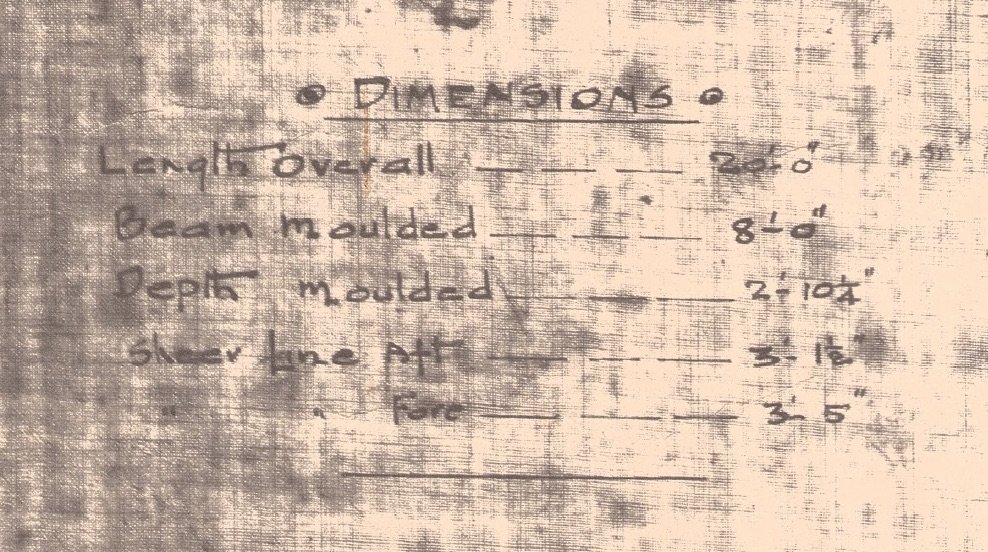
The lines show a shallow dishy hull with clean underwater lines; the shape is beamy & shallow. A 40% beam:length ratio is wide, but beamy is (or was) quite common in Sydney:
Here, cantering under spinnaker at Pittwater, in the early 30s:
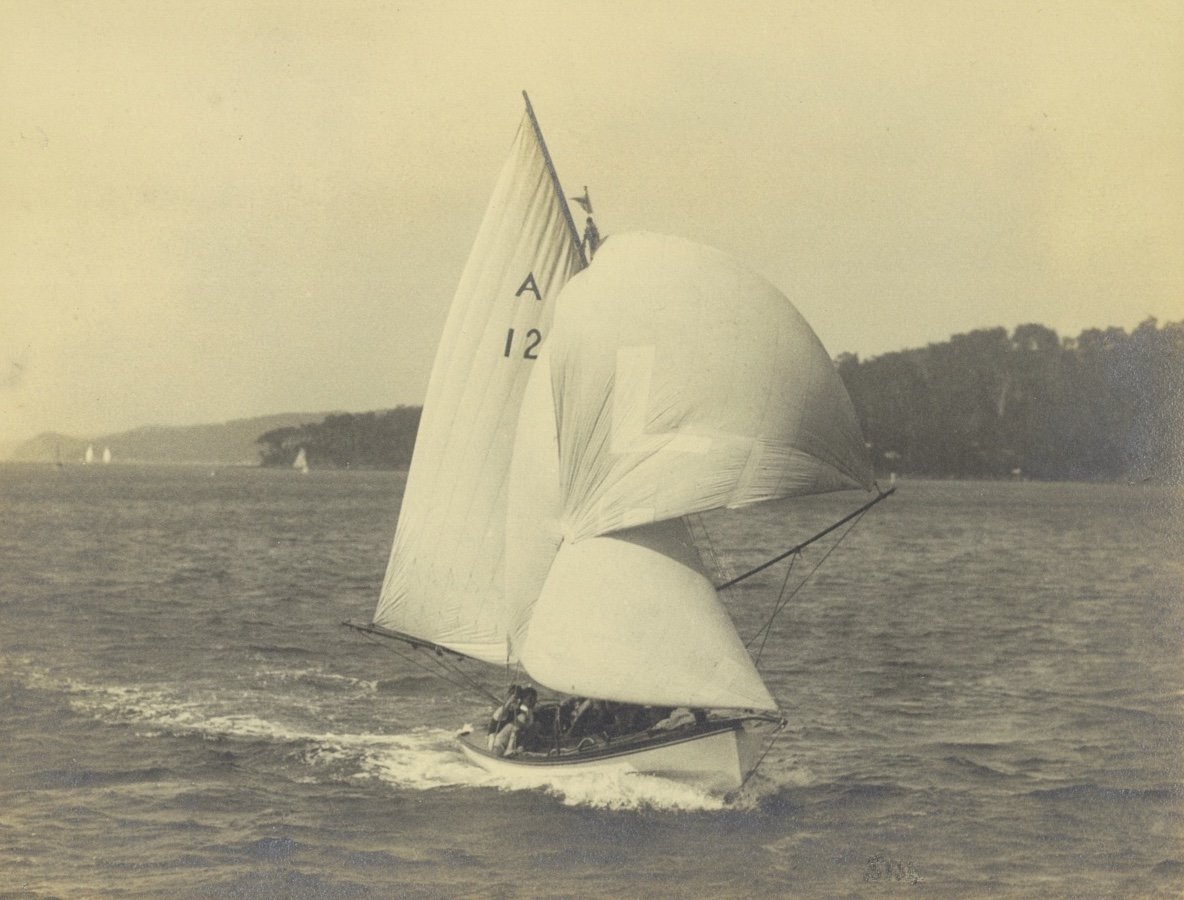
This is the rebuilt version, she was slightly lengthened & made finer in the bow. Interestingly the owner's one comment is that she tends to bury the bow downwind under spinnaker. I'm guessing the original didn't do that, or as much, with more buoyancy in the bow.
On the left, A12, with a removable cuddy cabin for cruising.
- G.L., mtaylor, Jim Cricket and 8 others
-
 11
11
-


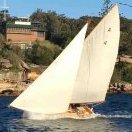
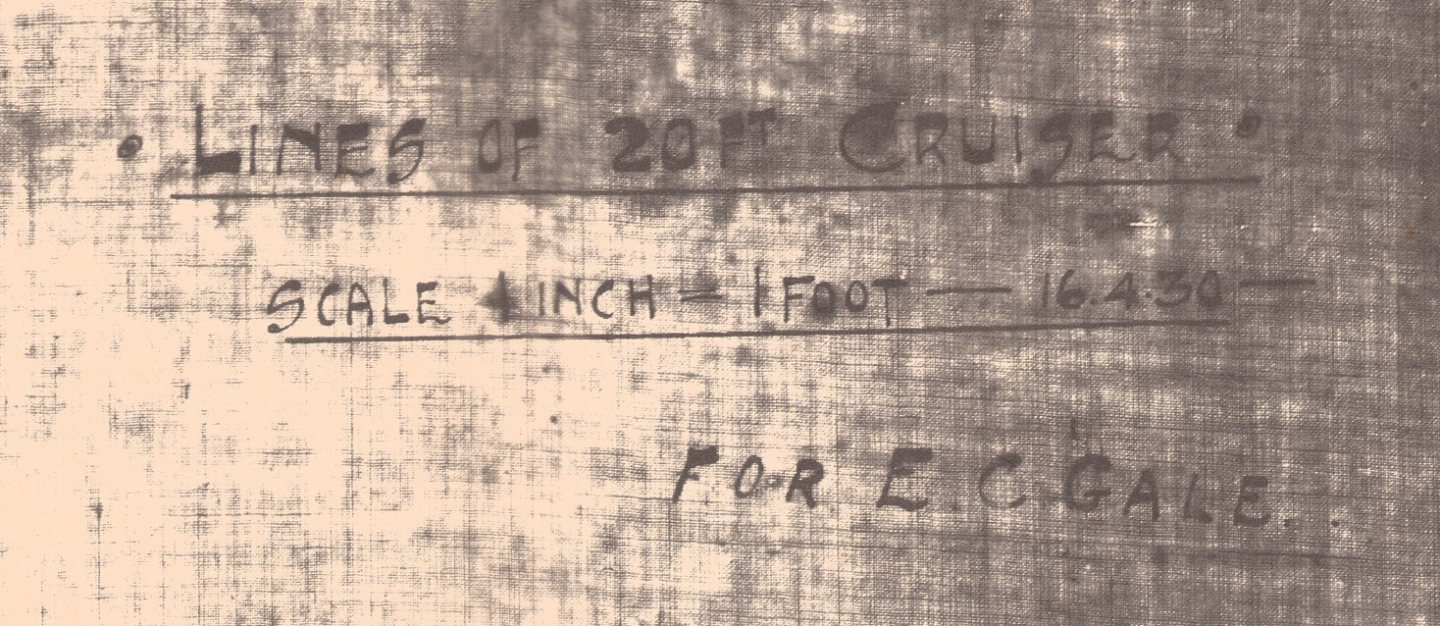
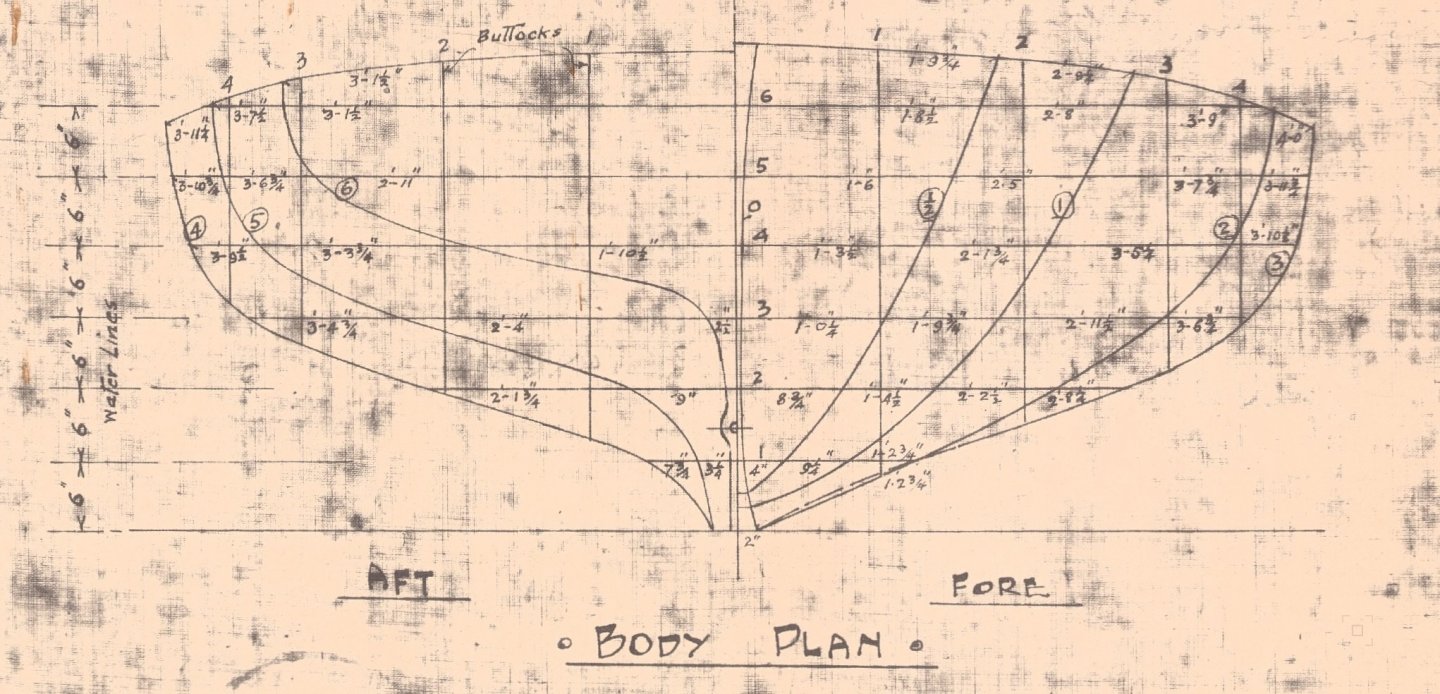


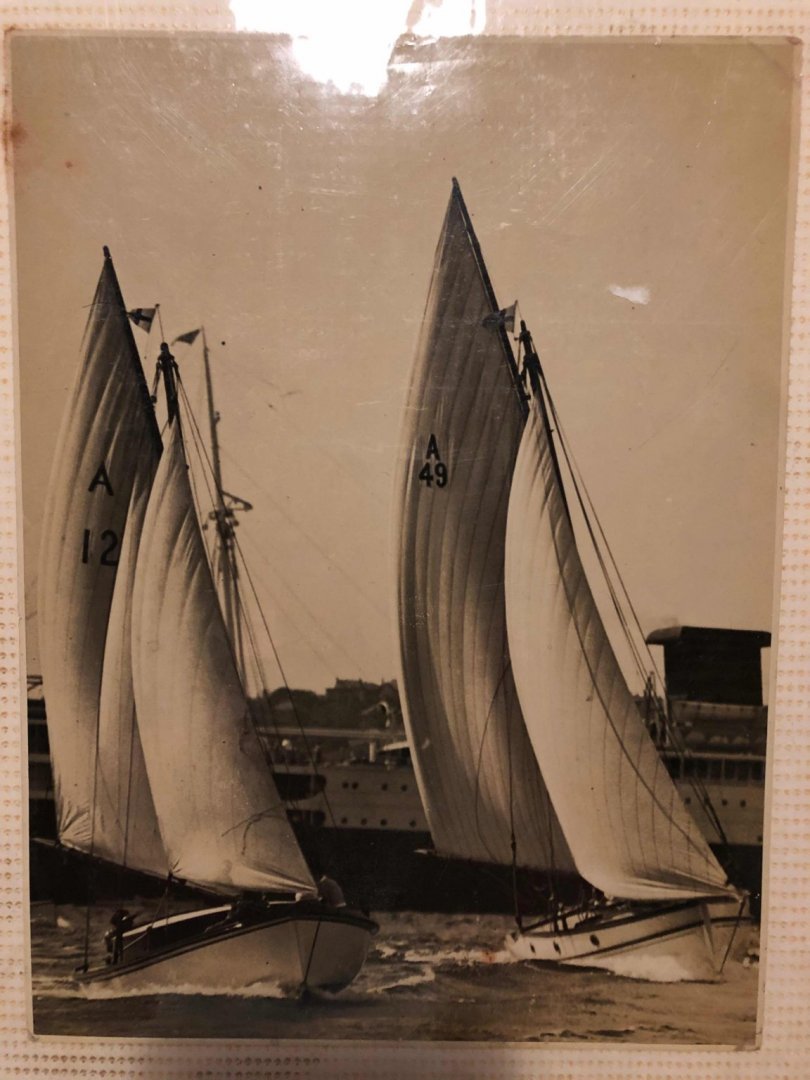
10th-11th century Byzantine dromon by Louie da fly - FINISHED - 1:50
in - Subjects built Up to and including 1500 AD
Posted
Hi Steven
I'm not trying to bring on another round of pun-making, but have you considered any underhand grips?